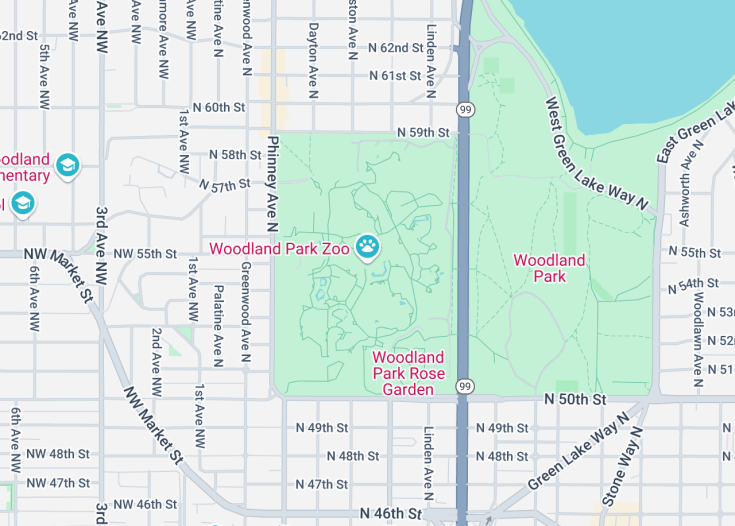Located in the heart of Seattle, Washington, the Woodland Park Zoo spans 92 acres and is a cherished destination for wildlife enthusiasts and families alike. Home to over 1,000 animals from different habitats and regions around the world, the zoo is renowned for its dedication to conservation and education. Visitors can explore a variety of exhibits, including tropical rain forests, savannas, and temperate forests, making each visit a unique encounter with nature’s marvels.
Plan your visit during weekdays or early mornings to avoid crowds and have more intimate experiences with wildlife.
Consider purchasing a membership if you plan multiple visits. It offers great value and exclusive perks such as free parking and discounts.
Woodland Park Zoo: A delight for nature lovers
Located in the vibrant city of Seattle, Washington, the Woodland Park Zoo spans across 92 acres and is a treasure trove of biodiversity and conservation success stories. Home to over 1,000 animals from different corners of the globe, the zoo plays a pivotal role in wildlife conservation through global projects and a commitment to sustainability. Offering a spectacular display of exotic species and immersive habitats, this zoo attracts visitors from all walks of life. It’s not merely about observing animals; the zoo emphasizes educational programs, interactive activities, and conservation work, making it a perfect destination for families and wildlife enthusiasts alike. The lush paths and well-crafted habitats enable a deeper understanding and appreciation of the natural world. The Woodland Park Zoo is thus much more than a typical zoo—it is a vital educational and environmental institution contributing to the ongoing efforts to protect and understand wildlife and their habitats.
Exploring Woodland Park Zoo
Visitors to Woodland Park Zoo can dive into a variety of experiences and exhibits tailored to educate and inspire. The Tropical Rain Forest exhibit transports guests into the dense, humid climates of Central America, creating an intimate experience with jaguars, lemurs, and a vibrant array of birds. In contrast, the Northern Trail replicates the environments of North America’s far northern parts, featuring animals such as grizzly bears, wolves, and elk in spacious habitats that closely mimic their natural surroundings. For those interested in conservation, the zoo’s on-site initiatives provide insight into wildlife preservation techniques and offer opportunities to participate in conservation programs. Educational sessions and feedings occur daily, allowing visitors to learn directly from caretakers.
An enchanting encounter
Among the must-see attractions at the Woodland Park Zoo is the award-winning Humboldt Penguin exhibit. This specially designed habitat features a simulated rocky coastline and a spacious pool that allows visitors to watch these charismatic creatures swim with astounding agility. With an emphasis on conservation, the zoo provides insights into their efforts to protect this vulnerable species and their natural habitats. Observing the penguins as they elegantly dive and interact in the water is both a delightful and enriching experience, highlighting the zoo’s commitment to animal welfare and environmental stewardship.
Discover the wonders of Woodland Park Zoo
Whether you’re planning a family day out or looking for a charming date destination, Woodland Park Zoo caters to all. This beloved zoo offers an impressive array of exhibits and experiences, making it a perfect spot for kids, couples, and wildlife enthusiasts of all ages. Visitors can expect a day filled with learning about diverse species, engaging in fun activities, and enjoying the beautifully maintained grounds.
Find the best time for your Woodland Park Zoo adventure
The ideal times to visit Woodland Park Zoo are during the spring and fall. These seasons provide pleasant weather, allowing you to comfortably explore the vast grounds and view animals in their most active states. For those looking to capture a special zoo experience, visiting during special events is a must.
ZooLights festival
The annual ZooLights festival, held during the winter holidays, transforms the zoo with breathtaking light displays. This event is perfect for families and couples alike.
Accessibility and limitations at Woodland Park Zoo
Please consider the following essential information to ensure a smooth and enjoyable trip.
Accessibility
The zoo is committed to being accessible to all visitors. Facilities include wheelchair-accessible paths, low-incline ramps, and accessible restrooms. Wheelchairs can be rented at the entrance.
Limitations
When planning your visit, keep in mind the following restrictions:
- No pets allowed (service animals excepted)
- Smoking is prohibited throughout the zoo
Notes to visitors
Just a few extra tips:
- Consider bringing a water bottle; refill stations are available throughout the zoo.
- Please respect the barriers and stay at a safe distance from the animal enclosures.
General informations
Here are some handy details for your visit to Woodland Park Zoo.
Location
Located near vibrant neighborhoods and easily reachable via major roads. Nearby landmarks include the Green Lake Park.
Address: 5500 Phinney Ave. N, Seattle, WA 98103, USA
Opening hours
Open daily from 09:30 AM to 06:00 PM. The zoo is closed on Thanksgiving and Christmas Day.
Getting to Woodland Park Zoo
Located centrally in Seattle, Woodland Park Zoo is accessible from major nearby cities and locales frequented by tourists.
Car
Driving is a convenient option with on-site parking available. The parking fee helps fund zoo maintenance and conservation efforts.
| Route | Distance | Travel time |
|---|---|---|
| From Downtown Seattle | 5 miles (8 km) | 15 minutes |
| From Bellevue | 10 miles (16 km) | 20 minutes |
| From Tacoma | 35 miles (56 km) | 45 minutes |
Public Transport
Accessible via bus from downtown and neighboring areas. Here are the typical travel times:
- From Downtown Seattle – 20 minutes
- From Bellevue – 35 minutes
- From Tacoma – 70 minutes
Nearby Attractions
Explore other interesting spots around Woodland Park Zoo:
- Green Lake Park – 0.5 miles (0.8 km)
- Museum of History & Industry – 3 miles (4.8 km)
- Seattle Art Museum – 5 miles (8 km)
Common questions
What are the main animal exhibits at Woodland Park Zoo?
- Tropical Rain Forest: Home to jaguars, lemurs, and a diverse array of birds and amphibians.
- Temperate Forest: Features species such as red pandas and gray wolves.
- African Savanna: Offers a broad expanse that houses giraffes, zebras, ostriches, and lions.
- Assam Rhino Reserve: Focuses on conservation of rhinoceroses and includes other Indian wildlife.
- Northern Trail: Mimics the habitats of North America with animals such as brown bears and bald eagles.
- Australasia: Home to kangaroos and wallaroos.
- Humboldt Penguins: Dedicated area for these unique, endangered penguins from South America’s coast.
These exhibits are designed to educate and inspire visitors about the importance of wildlife conservation while providing a close-up look at these amazing creatures in environments that mimic their natural habitats.
Can you interact with any animals at Woodland Park Zoo?
- Animal Feeding Experiences: Opportunities to feed certain animals, like birds in the Willawong Station where guests can feed seed sticks to free-flying birds under staff supervision.
- Zoomazium: An indoor, interactive area where children can engage in play-based learning about animals and their habitats.
- Close Encounters: Scheduled times when visitors can get up close with certain animals and learn directly from the caregivers about the species.
These controlled interactions are designed to provide educative insights into animal behavior and the importance of conservation while remaining respectful and conscious of the animal’s well-being.
Are there any educational programs offered by Woodland Park Zoo?
- ZooClasses: Offered to various age groups, these classes teach about animal behavior, biology, and conservation through interactive activities and guided zoo tours.
- Camp Programs: Summer and school break camps that offer immersive educational experiences.
- Conservation Talks: Scheduled talks by experts in the fields of zoology and conservation, providing insights into global wildlife issues and efforts.
- Veterinary Program: Displays and discussions around the care and medical treatment of zoo animals.
These programs are designed to foster a deeper connection and responsibility towards wildlife and environmental conservation among participants of all ages.
What types of flora can be seen at Woodland Park Zoo?
- Tropical Rain Forest: Lush, green foliage that includes exotic palms and a variety of ferns.
- Temperate Forest: Native and exotic shrubs, deciduous, and evergreen trees typical of temperate climates.
- Rose Garden: Adjacent to the zoo, this garden features diverse varieties of roses and is a favorite amongst botanical enthusiasts.
- Butterfly Garden: Hosts plants that attract native butterflies, creating a vibrant and educational display.
These gardens are not only breathtaking but are also geared towards educational purposes, emphasizing the importance of plant conservation.
How does Woodland Park Zoo contribute to wildlife conservation?
- Species Survival Plans: Participation in these plans helps manage and conserve endangered species through collaborative breeding programs.
- Field Projects: Support and involvement in over 35 field projects across the globe that focus on habitat preservation, wildlife protection, and community involvement.
- Research: Conducting and facilitating research that contributes to the understanding of animal behavior and conservation strategies.
- Education: Offering extensive educational programs that promote conservation awareness and actions among visitors and the wider community.
Through these actions, the zoo not only enhances the lives of its own animals but contributes substantially to global biodiversity protection.
Does Woodland Park Zoo accommodate special events?
- Alvord Broadleaf Theater: A versatile outdoor space suitable for large gatherings and events.
- North Meadow: A scenic outdoor area ideal for casual events and larger crowd assemblies.
- Woodland Park zoo’s zoo areas: Specific exhibit areas can be rented for a more immersive experience amongst the zoo’s habitats.
These spaces provide a unique backdrop, surrounded by the zoo’s flora and fauna, making any event memorable. Additionally, the zoo’s event staff assist in planning and coordinating to ensure a seamless experience.
Are there facilities for educational trips and school visits at Woodland Park Zoo?
- Guided Tours: Educators can lead students through the zoo, focusing on specific exhibits that align with curriculum topics.
- Hands-On Learning: Interactive programs that allow students to engage directly with the natural world.
- Resource Materials: The zoo provides teachers with materials to help prepare for and follow up on their visits.
- Workshops: Engaging workshops that enhance learning through more in-depth explorations of zoological topics.
These educational services are designed to bolster classroom learning, providing students with a tangible and interactive learning environment.
What kinds of volunteer opportunities are available at Woodland Park Zoo?
- Zoo Ambassadors: Volunteers help by providing information to visitors, assisting in navigation, and sharing insights about the exhibits.
- Educational Docents: Engage with visitors by conducting educational talks and guiding tours that emphasize animal conservation and biology.
- Horticulture Assistance: Volunteers can help maintain the zoo’s botanical collections, aiding in garden care and landscape projects.
- Special Events Support: During special events, volunteers can help with organization and management, ensuring these events run smoothly.
These roles not only help the zoo operate more effectively, but they also offer individuals a rewarding way to make a difference in conservation efforts and animal care.

Is the Woodland Park Zoo in Seattle worth visiting?
The Woodland Park Zoo in Seattle can be seen as worthwhile for certain tourists, but it depends largely on what you seek from the zoo experience. If you are enthusiastic about a broad range of animal species, it has a collection that spans several continents including elephants, gorillas, and tigers, which might appeal to animal lovers. However, some visitors might find that it lacks interactive and unique exhibits which are becoming more common in other major zoos. The zoo’s effort in conservation and education is noteworthy. Yet, for those seeking a more engaging or modern experience, they may find it a bit traditional. Ultimately, assessing if a visit is worth it should align with personal interests in wildlife and conservation efforts.










